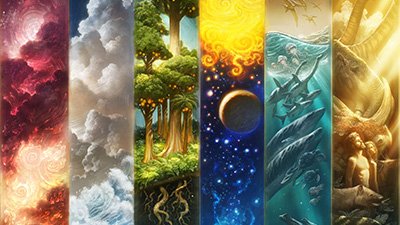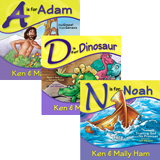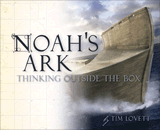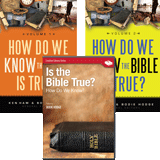Top 15 Illustration Problems in Genesis 1–11
From time to time people write books or articles with illustrations on the early pages of Genesis. Oftentimes, I see illustrated Bibles, particularly children’s Bibles or books on Genesis, that make the same classic mistakes.
In fact, I’ve seen so many of these books that I decided to list the classic mistakes in the illustrations (and a few extra ones dealing with the text) in hopes that artists and authors can use this in the future to make their books more accurate and effective.
When I see some brilliant artwork with inaccuracies in the illustrations or text, I usually stop and sigh because I really wish the message was accurate so that as a ministry we can say, “Here is a good product you can use to train the next generation.” But these errors creep in, often due to simply looking at someone else’s artwork with the same mistakes, and it subtly undermines the Bible right from the start. We want people to realize the Bible is true right from the start, so it is good to avoid common mistakes and correct some of the artwork depicting the events of Genesis 1–11—the foundational chapters of Scripture.
Here are some of the common problems I have found in the first eleven chapters of Genesis:
- The globe looks like it does today: This would specifically be before the Flood in Genesis 6–8. The Earth was destroyed and rearrangements on a continental scale resulted from the Flood. In light of Genesis 1:9, many believe there was only one continent originally. Though we should not be dogmatic on this position, we know the Flood caused vast changes, leaving us with the seven broken continents we have today (Genesis 7:11; Psalm 104:8–9).
- Leaving open evolutionary ideas: There is no need to impose evolutionary ideas on the Bible. These ideas come from the religion of humanism, and it contradicts the Bible. Sadly, some artists do mix humanistic thinking [like astronomical evolution (big bang as in progressive creation), geological evolution (millions of years as in the gap theory or progressive creation), chemical evolution (chemical origin of life without God) or biological evolution (like theistic evolution)]. These things are usually placed prior to the first day of creation. But God created everything in six days (Exodus 20:11; 31:17), and the context shows these were normal-length days. There is no need to take secular ideas and force them into the Bible. This removes the Bible as the authority when it comes to the age of the Earth. One common example is showing stars in the background in pictures showing the creation of Earth—the sun, moon, and stars were created on Day Four, after the Earth.
- Not including extinct creatures like dinosaurs on Day Six: Dinosaurs were land animals after all, so they were made on Day Six just before mankind. The same is true with land-based insects. Also, there should be pterosaurs, bats, and flying insects with all of the birds and sea creatures like the plesiosaurs on Day Five with the fish and whales.
- Putting modern variations of animals in the creation scene: Zebras, Clydesdales, and donkeys are all part of the horse kind and came to look like they do today since the Flood as part of the one horse kind. Species and the biblical kind are not necessarily the same things. The original horse kind likely had features resembling each of these. They diversified into what we have today through natural selection in the wild and artificial selection for man’s benefit. The same is true with the cat kind. Domestic cats, lions, bobcats, tigers, and so on, are all varieties in the one cat kind that have developed through variation since the Flood. It is better to draw generic representatives of each kind, such as the cats, horses, parrots, deer, and elephants (which includes mammoths and mastodons, Asian, African, and so on). The various animals and plants within a created kind could have been created with some variety, but the odds of that variety being identical with post-Flood variations are astronomical, nor does the Bible allude to this being the case. The fossils from the Flood do not attest to identical selection features within the kinds compared to what we have today. Though there may be some examples where little change has occurred in that particular kind, animals that have great variation like mammals and reptiles should not be drawn exactly like animals today. Likewise, a Triceratops doesn’t necessarily represent the Ceratopsian kind that God originally created. It is only one of many forms we find in the fossil record.
- Drawing Adam and Eve with very light skin and blond hair and blue eyes: Adam and Eve were likely middle brown, having the information for both darker skin (which is largely based on more melanin production in skin) and lighter skin (likewise, less melanin production in the skin). Thus even in one generation they could have had children that were darker or lighter in skin shade. The same sort of thing is likely true with Noah.
- Making an apple the fruit: The fruit was real and came from a fruit tree named the Tree of the Knowledge of Good and Evil. We don’t know what it looked like, but since it was “pleasant to the eyes,” it probably wasn’t too repulsive (Genesis 3:6.) But there is no reason to assume the fruit was an apple.
- Having a serpent without some form of upright posture or appendages during the deception: Genesis 3:1 calls it a serpent. Part of the Curse was that the serpent was to crawl on its belly. This may indicate that the Curse produced a snake or a serpent with shortened legs. So it is better to have a serpent more upright prior to the Curse and lower (i.e., crawling on its belly) after the Curse.
- Neglecting that God sacrificed animals to cover Adam and Eve: This is the very basis for the gospel in Genesis 3. The punishment for sin was death (Genesis 2:17), so death was part of the solution. This sin-death relationship is why Jesus Christ stepped into history to die for our sins. God covered Adam and Eve with skins (Genesis 3:21) to replace the fig leaf coverings Adam and Eve tried to make for themselves. This is the basis for wearing clothing (to cover the shame of sin) and for the sacrificial systems that Abel, Noah, Abraham, Jacob, Job, and the Israelites followed. The sacrifice of animals was not good enough to satisfy God’s wrath upon sin. The punishment from an infinite and holy God is an infinite punishment. We needed Jesus Christ, the Son of God, who is infinite, to pay the infinite punishment we deserve, and only He could truly bear the punishment and satisfy the wrath of God so that the free gift of salvation could be offered. The very basis for the gospel is found in this first sacrifice. Many illustrators or even children’s Bibles (and so on) neglect the Fall and even have Adam and Eve remaining in fig-leaf clothing. This needs to be remedied to accurately reflect life after the Fall and our need for a Savior.
- When illustrating Cain and Abel, we often get the impression they were the only two kids Adam and Eve had at the time: First, Cain had a wife per Genesis 4:17 (i.e., a sister or niece—either way, brothers and sisters had to marry originally, and this was okay until after the Exodus with Moses giving the Law in Leviticus 18). Remember, Abraham married his half-sister, and Moses’ father (Amram) married his aunt (Jochebed). Genesis 5:4 indicates that Adam and Eve had other sons and daughters after Seth. Since the Bible mentions a girl and two boys before Seth, as well as all those whom Cain feared in Genesis 4:14, there were surely several other children by the time Cain killed Abel.
- Ark looks like a bathtub with happy animals sticking out of it: The Ark was a huge vessel measuring an overall 300 by 50 by 30 cubits. Depending on the long or short cubit, it was either about 450 feet long or about 510 feet long (a long/older cubit was a hand-breadth longer than the normal cubit, which was the measurement from a person’s fingertips to their elbow). The longer cubit of about 20.4 inches is more likely since most ancient structures in the Bible were built using the longer/royal cubit, like Solomon’s Temple (2 Chronicles 3:3), and this is made clear in the description of the cubit used in the Temple mentioned by Ezekiel (Ezekiel 40:5). Animals were confined in rooms inside the Ark, and it wasn’t a happy time. God was judging sin and, except for the eight on the Ark, the whole world perished (2 Peter 3:6). Noah probably had brothers and sisters die in the Flood (Genesis 5:30). The dimensions for the Ark give the total length, width, and height. Some picture it as a box shape, which is better than the bathtub look, but we need to keep in mind a Corvette’s dimensions can also be given as length, width, and height too, yet it is not a box. The Ark was a ship, so it should have features like a ship to help it survive the Flood, even though it did not have to navigate to any specific location. Removing square angles that can more easily be destroyed and having something to help direct it into the wind and waves for safety should be drawn to make it more realistic. The Bible doesn’t rule out this sort of design.
- Not including dinosaurs and pterodactyls (e.g., dragons) on the Ark: According to Genesis 6:20, these animal kinds would have been on the Ark. It was after the Flood that these animals died off. It was for the same reasons all sorts of animals went extinct and continue to . . . sin! Specific reasons for the extinction of dinosaurs include being hunted, a changed environment, genetic problems, local catastrophic events, diseases, and so on (i.e., think of the reasons on the endangered species list). So two of the sauropod kind, two of ceratopsian kind, and so on, should be included.
- Putting too many individuals of a kind on the Ark: We often see lions and tigers and other cats entering or exiting Noah’s Ark.1 There is only one cat kind (cats can interbreed with each other), so Noah only took two cats on the Ark. Of course, they had the genetic information which can account for the cat variations we see today (as a result of various selection processes over time). The same with dogs—there is only one dog kind, so Noah only needed two dogs on the Ark, no dingoes, wolves, coyotes, and so on. The same goes for the bear kind, ceratopsian kind, sauropod kind, elephant kind, horse kind (zebras are part of the horse kind—they are a variation of the horse that is post-Flood), and so on. Learn more about kinds.
- Tower of Babel being rounded: It was likely a pyramid or a ziggurat (step pyramid) instead of rounded. The Hebrew word for tower here is migdal, which is most often translated as “tower,” figuratively means a “pyramidal” bed of flowers. A ziggurat-style shape makes sense since this is the same style building project people took with them to other places around the world after fleeing from Babel. Pyramids are a specified type of ziggurat. Even historical accounts like that of Herodotus (an old Greek historian in the 5th century BC who saw the Tower of Babel before it was torn down) described it as a ziggurat.2 There is also an archaeological artifact, the Tower of Babel stele, which has Nebuchadnezzar and the old run-down Tower of Babel engraved on it, and the tower is a ziggurat shape.
- Tower of Babel reaches so high into the atmosphere that its top is covered with high cirrus clouds: It was a tower whose “
top was in the heavens
” (Genesis 11:4), but this does not mean it reached to space or the high stratosphere. Some of the 30 or so ziggurats that still remain in the Mesopotamian area have names that reflect something similar: Temple of the Stairway to Pure Heaven (Sippar) and the Temple which Links Heaven and Earth (Larsa), yet these towers do not reach up into the stratosphere. It simply meant that it reached far higher than the rest of the structures around it. - The Tower being only partially built (i.e., a foundation): The Tower was built, according to Genesis 11:5 by most translations; it was the city that they stopped building (Genesis 11:8.) This has often been a point of confusion for many. Some have thought that the Hebrew wording doesn’t mean it was built, but the word for built/building is banah/baanuw and is used in a perfect tense meaning complete, e.g., perhaps some finishing touches were necessary. This could be complete up to a certain point (at the time of judgment) to serve the purpose if its final intent by keeping people from scattering. It is the context that should determine this. Many point to verse 8, but this only helps with the meaning regarding the state of the city, not the Tower. We can be confident that for the most part it was complete (e.g., the Tower was not a merely a foundation). If one argued that the Tower was not built to any significant degree, then one would have to argue that hosts of structures in the Old Testament were also not built, such as the Temple (e.g., 1 Kings 10:4), many houses (e.g., 1 Kings 9:24), many cities (e.g., Numbers 32:37–38), and so on since they all use this same Hebrew word in a perfect tense.3 Furthermore, banah is used not just in reference to the Tower but also to the city in verse 5. If we were to argue the tower was not built, then we would have to argue that the city was not built to any degree either.4
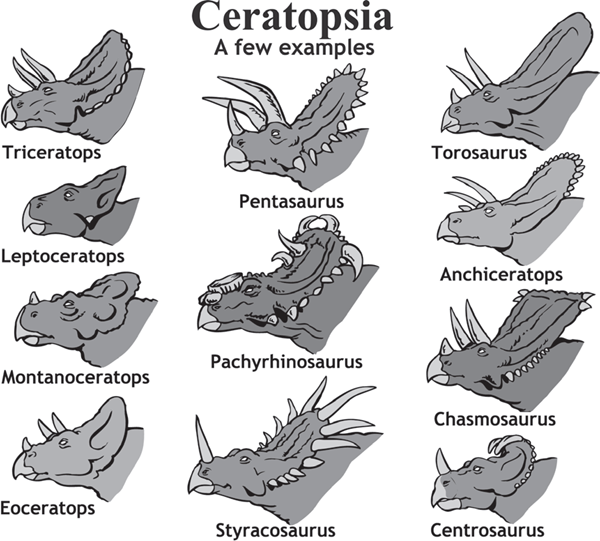
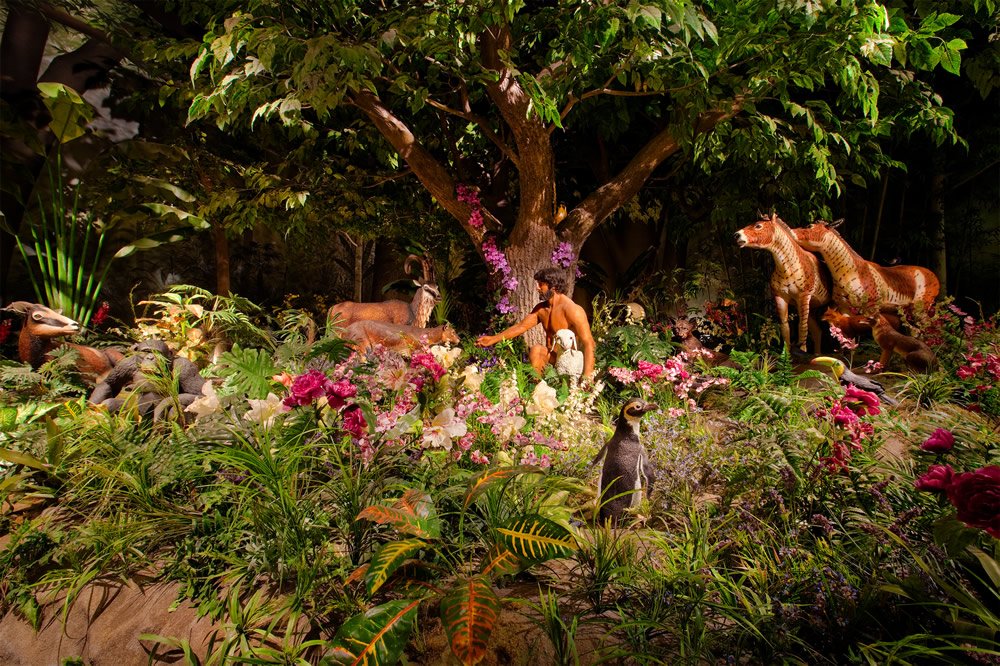
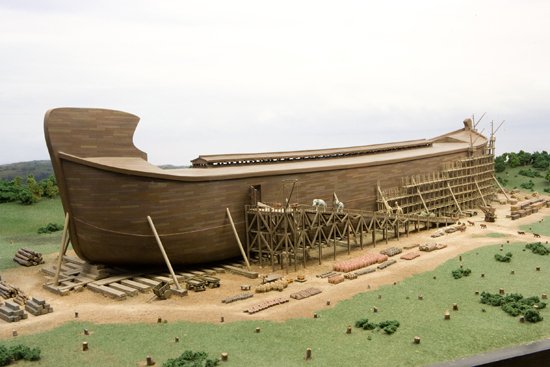
Here are a couple more helpful guidelines that can be useful when dealing with the text in an illustrated Bible.
- Not using biblical dates: Why use secular timeframes instead of biblical timeframes when publishing a Bible? For example, don’t use BCE and CE; use BC and AD to honor Jesus as the focal point of history. Also, use biblical dates from a respected chronology like Ussher or Jones, not questionable dates that come from faulty assumptions like secular mythology or radiometric dates that are repeatedly in error. Stick to the biblical age of the Earth and dates given in the Bible.
- Calling the accounts “stories”: Although “story” does not necessarily imply myth or fairy tale, it is becoming more popular for people to use it in reference to fairy tales in today’s culture (e.g., Cinderella, Shrek, and so on). Bible authors did not view the Bible’s recorded history as fairy tales but as actual history—accurate accounts of what took place. Hence, it is better to say “account,” “history,” “what occurred in the past,” and so on.
- Don’t paraphrase the Bible—use a respectable translation: What often happens is that people want to “dumb down” or truncate the text for children, but this often introduces errors from the author—it can happen to all of us. People can understand more than many might think, including children.
- Placing the Garden of Eden based on post-Flood geography: Many try to put the Garden of Eden in the Middle East, in Iraq. However, the Flood destroyed the Garden of Eden, and the Tigris and Euphrates Rivers were later merely named for these pre-Flood rivers. The geography doesn’t match—direction of flow, and so on. There was one river in Eden that broke into four headwaters, so these modern rivers cannot be the rivers mentioned in Genesis 2.
Hopefully, these will help get you started as you evaluate teaching materials or seek to develop your own. But keep in mind there may be other mistakes, and all these must be checked against the text of Scripture—the authority when it comes to these matters.
Footnotes
- When animals came off the Ark, they came off by their “families” (Genesis 8:19), so it is possible some animals had offspring while aboard the year-long trip on the Ark. But this doesn’t mean we should have full-grown bobcats, lions, tigers, and so on coming off in great quantities from the cat kind.
- Herodotus, The Histories, Book 1.181, ed. John Marincola, translated by Aubrey de Selincourt in 1954, Penguin Books, 1996, pp. 71-72.
- The LXX added the word tower to Genesis 11:8 in their translation without biblical warrant, and this has likely been the main reason some still think the Tower was partially built. The LXX is good in many places, but is not known as a good translation in Genesis, messing up the ages of the patriarchs [e.g., Noah’s grandfather Methuselah would be living over a decade after the Flood without being on the Ark; mistranslates “sons” as angels in Genesis 6:2 (6:3 by the LXX’s reckoning); mixing the Greek philosophy of the day by having a solid dome to translate expanse (raqiya) as something solid and firm, and so on]. So by sticking with the Masoretic text (standard Hebrew text), there is no reason to assume the Tower is in reference to what was “ceased to be built.” Also, can large structures be built quickly? About 800 years ago, Richard the Lionheart and his men, while in France, built a huge castle fortress in the course of about one year. Its impressive remains still stand today and is called the Chateau Gaillard above the River Seine in Normandy, France. A determined group of people can perform enormous feats quickly, and the people in Genesis 11:1–4 were indeed determined.
- One may argue that Genesis 11:6 (“
and this is what they begin to do
”) is in reference to the Tower being built. But it makes more sense that the Lord is making this declaration to their sinful intention of defying His Word where he told them to be fruitful and multiply and fill the earth after the Flood in Genesis 9:1 and 9:7. Also, the oldest recorded image thought to be of the Tower of Babel is an inscribed stele with Nebuchadnezzar II and the image shows a virtually complete Tower. See Rossella Lorenzi, “Ancient Texts Part of Earliest Known Documents,” Discovery News, December 27, 2011, available at https://www.seeker.com/ancient-texts-part-of-earliest-known-documents-1765572672.html.
Recommended Resources

Answers in Genesis is an apologetics ministry, dedicated to helping Christians defend their faith and proclaim the good news of Jesus Christ.
- Customer Service 800.778.3390
- © 2024 Answers in Genesis



